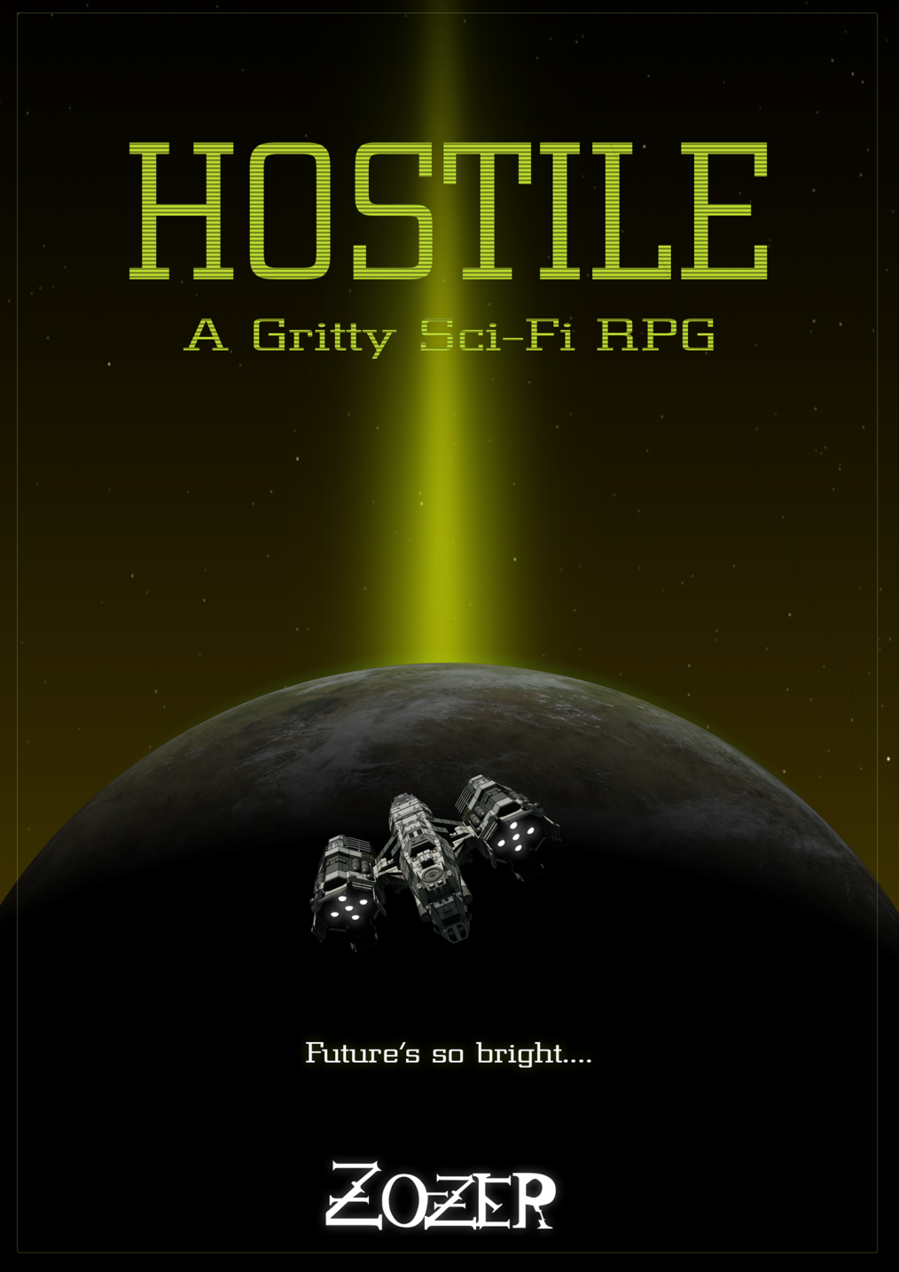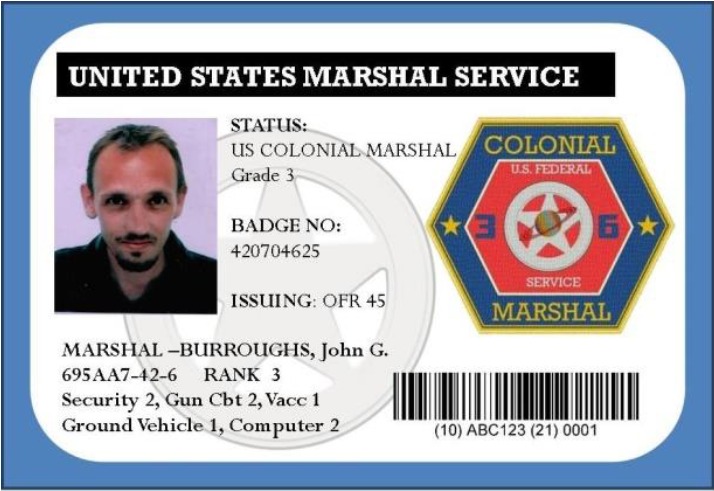Hostile: A Gritty Sci-Fi RPG
This article originally appeared in the March/April 2018 issue.
 Hostile.
Paul Eliott.
Hostile.
Paul Eliott.
Zozer Games https://www.paulelliottbooks.com/zozergames.html
307pp., PDF
US$19.99/UKú14.30
Hostile is the real deal.
Admit it—you watched Alien (and Aliens), Outland, Blade Runner, and many other 1970s and early-1980s sci-fi films. You loved them. You’ve always wanted to run role-playing games in their settings. There was once a relatively obscure Aliens RPG published in 1991. Classic Traveller also comes quite close to Alien/Aliens. However, none of them captures the spirit of these “retro-industrial” hard-line 1970s universe as brilliantly as Hostile does.
The entire thing oozes atmosphere. It is clear that the author knows the milieu like the back of his hand and has analyzed it, dissecting it to its most basic elements: a focus on work and working-class heroes; industrialization and an “industrial” look and feel; danger lurking in the many corners of space; anthropocentric milieu; retro-futurism; and a hearty dose of cynicism. It provides a list of several movies inspiring Hostile games, from Alien to Elysium.
Also, it lists Red Dwarf as inspiration! And also mentions it again as a source of adventure inspiration! BONUS POINTS!
Hostile comes in the form of five PDF files:
- 1970s-style Classic Traveller-inspired rules. These are almost exclusively combat rules, which supplement the many rules included in Hostile. However, ship combat is still absent.
- A PDF with 15 floor plans of various “space colony” locations, from Aliens-style colonial corridors to a warehouse.
- An in-universe starship-trade “magazine” showcasing the Hercules-class tug, which is, in a nutshell, the Nostromo (of Alien fame) with its serial numbers filed off.
- A Hostile-specific character sheet, in the shape of an in-universe PERSONNEL Form.
- The Hostile book itself.
After this introduction, there is a 9-page setting overview, out of which 3 pages are setting history, 3 are nation-state and corporate overview, and the rest is mostly art. I love this: short and to the point. History serves the setting. No need for long fluff here. Just the bare bones necessary to provide context to the rest of the book. Excellent game-design choice, in my humble opinion.
After that comes astrography. This is meaty–54 pages, most of which describe worlds. As in Aliens and 2300AD, Hostile organizes space into “arms” of human expansion into the stars. This book focuses on the American Arm. It also divides space into “Zones”, i.e., Traveller-style subsectors. The book includes six of these, in excellent blue-and-dark maps. Before the worlds, it overviews the standard Cepheus Engine/Traveller world generation rules, with minor modifications. The book details 23 worlds, all “Core” worlds, and then mentions “Frontier” worlds in a passing, without details. This is a shame—frontier colonies are a hotbed for adventure.
A major point of divergence from standard Cepheus Engine/Traveller is that of tech levels. Hostile combines TL15 in computers, robotics, and ship drives with TL10 in everything else. It also totally lacks cybernetics—remember, this is Blade Runner, not Johnny Mnemonic. Other than a short table on p.38, the book does not mention tech levels. As in Aliens, colonies have similar technology to that of the Core.
After this come the actual setting details—those of the “Big Seven” mega-corporations, the obligatory spacefaring USMC, the United States Space Command (refreshingly, a development of the Air Force rather than the Navy), starlines, NGOs, mercenaries (“Private Military Contractors” (PMCs)—Hostile uses the real-world contemporary term), non-profits, and criminals. Ah, and Antarctica Traffic Control! It also has the equivalent of Blade Runner Replicants, that is renegade psychopathic clones which authorities are trying to hunt down.
As in most third-party Traveller and Cepheus Engine settings, such as Clement Sector and These Stars Are Ours!, Hostile has a sizable character generation chapter. This follows standard Cepheus Engine rules, though with 15 new careers such as Corporate Exec (the replacement of a Noble), Marshal (frontier lawman), and Roughneck (space miner). There is also an option to play Alien/Aliens-style androids. They have several limitations, such as Asimov’s rules they are programmed to follow and limited skills, but still—playing an android is cool!
Also, there is this:

A perfect Classic Traveller/Cepheus Engine “character sheet” if there ever was one! Just add equipment on the back and start chasing star outlaws!
Similar to my own Outer Veil, Hostile provides equipment, complete with in-world brand names. Expect Pulse Rifles and an AK-equivalent. The equipment chapter also discusses technology as a whole in this setting. This is straight 1970s-mid-1980s sci-fi. No cellular phone, no flat or touch screens, no nanotechnology. Video-phones rule the day, as well as data cards and minidiscs. A great addition is in-universe “medicinal” names for the otherwise dry Traveller drug names; you will find ACE Inhibitor and Dexamphetamine here, not Slow Drug and Combat Drug. There are all sorts of equipment, as well as guns and vehicles. There are no gravitic vehicles in Hostile, so vehicles are restricted to pretty realistic ones, from cars to tilt-rotors. This chapter is very long, and has its fair share of “Gun Pr0n”.
Oh, and the Referee/GM is called here… The “Manager”!
The next chapter details styles of play and the general milieu, with adventure hooks aplenty. The three recommended play styles are Work, that is, playing corporate troubleshooters solving all sorts of nasty frontier problems; Fight, where the PMCs and the said obligatory space USMC come in; and Explore, which is boldly going where no man has gone before and probably getting eaten by a xenobeast as well. Hostile then gives many tips about how to run and describe an Aliens-style setting. This includes visual and auditory cues, as well as the main themes of the game. There is also an excellent discussion of horror gaming, with tips to the budding horror Referee (“Manager”). Including Xenomorphs. And Hyperspace anomalies! Hostile mentions Red Dwarf in the latter, which, again, is wonderful. I love that series!
There are also stats for various dangerous xenomorphs, including, as you expect, a Reticulan Parasite, i.e., an Alien (in TSAO!, of course, a “Reticulan Parasite” has another meaning ☺) and a creature inspired by the one from John Carpenter’s The Thing. The next section discusses environmental hazards, including radiation and a realistic depiction of vacuum exposure. Everything is well-detailed and clear: from extreme temperatures to poisonous atmospheres. I think that this chapter will be perfectly useful in other settings as well, as it is, in my opinion, superior to the discussion of these subjects in Mongoose Traveller or the 2D6 Sci-Fi SRD. The only downside is that the chapter only lists the amount of rads a given radiation source causes, but does not list their effects on the human body; this sends the player to browse the Cepheus Engine.
There are belting rules, along with some new equipment, which is very well thought out. The mining rules themselves remind me of my own old rules, a version of which appeared in Outer Veil—these are OGL, of course, and this pleases me very much.
The next big chunk of Hostile is starship construction. This is a major point of divergence from the Cepheus Engine core rules. Hostile ships are big; as big as those of old Classic Traveller Book 5: High Guard. Up to a million tons! However, maneuver drives are plasma reaction drives. Hyperspace engines require no fuel, but M-Drives require fuel similar to that of a Cepheus Engine core rules J-Drive. Thus, you can use ship designs from other 2D6 OGL-compatible products in Hostile, including their deck plans, with minimal adjustments.
This is “not-Alien/Aliens”, so while in Hyperspace transit, everyone must hibernate in Hypersleep or suffer horrid effects. Ships still have staterooms for in-system flight, though, and Hypersleep seems much safer than vanilla Traveller Low Berths. There are also shipboard medical facility rules (possibly) inspired by my own, but sadly no hydroponics, which would be, in my opinion, highly appropriate to this setting. Finally, the chapter clarifies the Cepheus Engine/2D6 SRD missile rules, which is a boon.
The book provides several ship designs, from tugs and refineries (ahem, Nostromo) to Naval patrol ships—similar to cruisers in Mongoose Traveller, I think. There are no deck plans, but there are beautiful renders of some of these ships.
Finally, there are adventure seeds—they are short, but there is a large number of them.
The book ends with some NPC stats—including a very well-known crew with its serial numbers (and names) filed off—and a filled character sheet example.
The bottom line is that this is a wonderful product. I think that, far more than a setting book, it is a genre toolbox. If you want a gritty, Alien-esque near-Terra, near-future setting, this is the book for you. If you want to build your own near-Terra, near-future setting, this book would also be of immense value to you.
Highly recommended!
 Freelance
Traveller
Freelance
Traveller